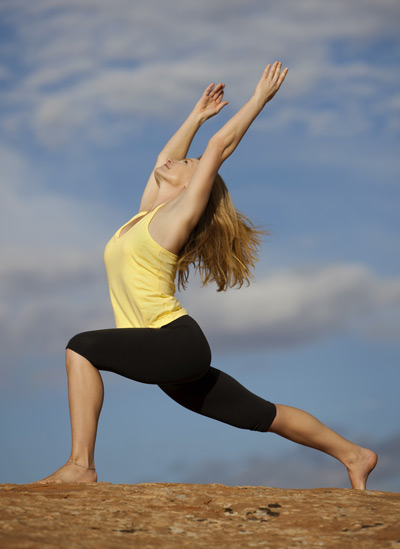 By Emily Delzell
By Emily Delzell
Yoga is becoming increasingly popular with students looking to improve strength, flexibility, balance, and well being. But those who do too much, too soon are at risk for injury.
Raza Awan, MD, hadn’t been practicing yoga long when he found himself in a class with a fairly advanced group of students. The instructor brought the students to the middle of the room to move into a handstand pose (in Sanskrit, adho mukha vrksasana, or downward facing tree pose, Figure 1). The sports medcine physician said he thought he’d be more comfortable using the wall for support, but the instructor said he looked strong. Rising into an unsteady handstand (his first), he toppled over (despite an assist from the instructor) and broke his big toe.1
He was using yoga to rehabilitate from injuries unrelated to the practice, as well as investigating its potential as a tool for his patients.
“About a decade ago, I started seriously looking at utilizing yoga to enhance rehabilitation outcomes in my patients and began bringing yoga practitioners into the sports clinic to becomes part of our rehabilitation team,” said Awan, a physiatrist and medical director of Synergy Sports Medicine & Rehabilitation in Toronto, Canada. “Ultimately, I wanted to ensure that if I was recommending yoga to my patients, I knew both the risks and benefits of yoga practice.”
As yoga gained popularity, he also started to notice more yoga-related injuries presenting in his clinic. The literature revealed little data on the injuries (and published data are still sparse) so Awan began tracking injuries in his patients to analyze patterns, identify high-risk poses, and improve clinical outcomes. Eventually, he began leading injury prevention workshops for teachers, studio owners, and students.

Figure 1. Handstand pose.
Traumatic injuries like the one Awan experienced aren’t the most common type of yoga-related injury, but his story does illustrate an important risk factor for all types of yoga injuries: an instructor who pushes students too far, too quickly. This high-risk pushing can be physical as well as mental.
“Injuries can be caused by too vigorous hands-on adjustments from teachers who may not be knowledgeable about the individual limits of their students’ bodies,” said Ann Wendel, PT, ATC, CMTPT, an American Physical Therapy Association spokesperson, Thai yoga therapist, and owner of Prana Physical Therapy in the Washington, DC, area.
Hands-on adjustments by yoga teachers are common, but not always benign.
“One of my clients who came to me to rehabilitate from a yoga injury got it during a retreat,” said Wendel. “She was in wide-angle seated forward bend pose [upavistha konasana, Figure 2] and the teacher leaned heavily into her back to force her forward, deeper into the pose—she heard a pop, and ended up with hamstring and low back strains.”
Most of the yoga-related injuries Awan has cataloged are from overuse.
“Performing the same poses over and over again over time can lead to repetitive strain and predispose to musculoskeletal injuries and conditions. In many cases the symptoms come on insidiously, and the patients may not make a causal link between the injury and yoga practice,” he said.
Chasing a shape: ego and injury
The biggest risk factors for getting hurt doing yoga aren’t pre-existing medical conditions or old injuries, but the students themselves, who often risk injury to reach full extensions in poses, or asanas, their bodies aren’t ready for (and may never be ready for), as well as teachers, who may lack adequate training, may be instructing classes too large for close supervision, or who introduce an attitude of competition—including competing against oneself —into classes.
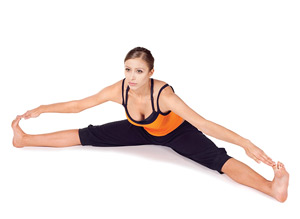
Figure 2. Wide-angle seated forward bend.
“Ego and not listening to your body are big risk factors for yoga injuries,” said Cristina González, a yoga teacher from Toronto who describes her practice as “rooted in the Ashtanga system with a healthy dose of Iyengar sensibilities.” Ashtanga yoga is a vigorous form of yoga with a specific sequence of poses (power and Vinyasa yoga are often variants of this type). Iyengar yoga emphasizes precise alignment in the pursuit of poses as well as the use of modifications, including straps, blocks, and other props, to achieve correct biomechanics and minimize the risk of injury.
“I injured myself quite a bit in yoga in my initial years of practice,” said González, who said she strained her hamstrings, hip, and injured her shoulder severely. “I was chasing a shape rather than an action. I’m pretty typical in some ways of the hypermobile person—I enjoy the sensation of stretching, and I wasn’t balancing it with proper muscular engagement.”
Awan agreed that in his experience hypermobile people are at higher risk for yoga injuries than people with more average range of motion.
“These patients may be drawn to yoga because they possess the range of motion to perform many common poses well, but hypermobility can be a particular risk factor for injury as the patients may not have good proprioception and may push too far into poses, which can cause damage to soft tissue structures over time,” Awan said. “Hypermobile patients may also lack the muscle strength and endurance to support a pose well, contributing to injury.”

Figure 3. Lotus pose.
Those with limited range of motion are at risk, as well.
“Hip and knee injuries can occur when people are trying to push their bodies into a pose,” Wendel said. “For example, forcing yourself into lotus pose [padmasana, Figure 3] can result in injury to the meniscus. There are real bony constraints in the hip, but the knee is much more flexible, so people may try to crank on the knee to get into that position, and that’s commonly how people tear their meniscus [in yoga].”
Meniscus injury is a documented risk of yoga. Chinese researchers reported in a 2012 study that women aged 20 to 49 years who practiced yoga (they didn’t specify type or specific poses) at least one hour a day were at higher risk of meniscus injury than that conferred by jogging, badminton, or climbing hills, and that risk increased with longer duration of practice.2
Wendel noted that, practicing in the Washington, DC area, she sees a lot of “Type A personalities.”
“They want to push, push, push and work out intensely, and when they take the mentality of pushing and competing and getting in a really vigorous workout into a yoga class, that’s when injuries are likely to occur,” she said.
A 2012 Australian survey, which included 2353 yoga practitioners who answered questions about practice-related injuries sustained in the previous year noted that the respondents commonly blamed themselves for injury, citing reasons that included “pushing it too far,” not warming up, and being “ego-driven.”3
Also potentially problematic are large classes in which it’s impossible for teachers to see how every student is interpreting his or her cues.
“I often attend large group classes out of curiosity and for inspiration, and sometimes I’ll look around the room and think, ‘Isn’t it interesting how many interpretations there are of that cue.’ Some of the language can get pretty esoteric, and I can see why they’ve interpreted it that way, but often it’s not good for the body,” González said.

Figure 4. Standing forward bend.
She began working as a yoga instructor 11 years ago teaching large group classes, moved to small groups of four people or fewer, and now teaches mainly one on one.
“I did this because, over time, I decided it was safer for my students,” said González, who has taken Awan’s yoga injury prevention workshops.
The type of yoga Wendel uses with her patients, Thai yoga, is also a one-on-one practice.
“It’s kind of ‘lazy man’s yoga,’ in which I actually assist the client into and out of different yoga postures, mostly to help with mobility and relaxation,” she said.
Class styles, yogi practice patterns
Indian spiritual practitioners began developing yoga in the fifth or sixth century BCE.4 More than 2000 years later, yoga gurus introduced it to students in the West, where, starting in the 1980s, it began to soar in popularity as an exercise form, leading to dozens of styles of this ancient practice.
Some more popular yoga styles now practiced in the West include Hatha, Anusara, Bikram (which falls under the larger umbrella of hot yoga), Vinyasa, Ashtanga, Iyengar, Flow, and Kripalu.5 But these represent only a small sampling of the many variants.
“Yoga practices in which the same poses are done repeatedly [eg, Ashtanga] seem to carry a higher risk of injury, in my experience,” Awan said. “Styles of yoga where certain high-risk poses are held for a very long time [as in Yin yoga] can predispose to injury. Conversely, faster styles of yoga [eg, Flow] where patients are going from pose to pose quickly without achieving good alignment can also predispose to injury.”
Yoga done in deliberately hot environments such as Bikram, a popular and intense type of yoga done in a room heated to more than 100° F, can also create risks.
“Yoga performed in an extremely hot or humid environment carries risks of heat-related injury,” he said. “There may also be a higher risk of musculoskeletal injuries in a heated room, as warm muscles can lead to patients inadvertently pushing too far into a pose. Yoga in a hot environment can also lead to poor judgment and potentially riskier behavior during a class.”
In addition, said González, every studio has a different culture.
“While I believe that most teachers of yogasana act according to the principle of ahimsa [nonviolence], the economics of keeping a yoga studio afloat may sometimes influence studio owners/managers to act otherwise. I do not believe that anyone intentionally injures students, but the demands of certain practices and postures do elevate risk,” she said. “For example, if a studio has a consistent client base that expects a ‘physically challenging’ class, the studio will likely continue to cater to that because it’s paying the rent. Some studios may offer classes in a style that is too dogmatic—poses arranged according to an unmodifiable sequence, overzealous physical adjustments that take students too deeply and too quickly into a pose, and a kind of misinterpretation of what it means to practice tapas [yogic discipline, which can be misunderstood as mastering difficult poses]. This may be conducive to an atmosphere where practitioners tune out or doubt warnings their body is giving them. Some studios/practices may encourage complete release and acceptance. This too can be misinterpreted dangerously.”
New yoga students who lack a fundamental understanding of the poses can be at risk for injury.
“Malalignment during poses and progressing to more advanced poses and classes before the body is ready can be risk factors for injury,” Awan said.
A 2007 survey conducted by the International Association of Yoga Therapists (IAYT) and others found that, among 1336 responders who answered questions about their practice and related injuries, the most commonly cited causes of injury were poor technique or alignment, previous injury, excess effort, and improper or inadequate instruction.5
The frequency and intensity of an individual’s practice can also create injury risks, Awan said.
“This may include taking weekend workshops or going on a yoga retreat,” he said. “Someone who has experienced a sudden increase in their yoga practice, particularly if they perform the same poses repeatedly, can be at risk of injury from repetitive strain. Yoga teacher trainees can also be at risk, as they are not only required to attend formal training, but often substantially increase their own asana practice.”
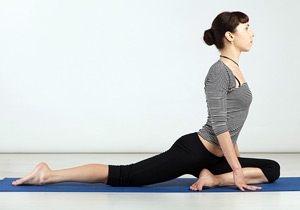
Figure 5. One-legged king pigeon pose.
Common injuries, risky poses
The hamstrings and knees are common lower extremity sites for yoga-related injury.
“Proximal hamstring tendinopathy, patellofemoral pain, and meniscal tears are some of the more frequently encountered lower extremity injuries I’ve seen,” Awan said. “Hip labral tears are not as common; however, they are important to identify, given the risk of long term disability if not diagnosed and treated effectively.”
He noted that poses with extremes of hip motion, such as end-range hip adduction/internal rotation or hip flexion/abduction/external rotation, can predispose to hip labral tears.
“This is particularly true in patients with an underlying anatomical predisposition such as femoroacetabular impingement,” he said. “Limiting the range of motion during these poses may potentially limit the risk of labral tears.”
A study of imaging observations by Canadian radiologists found that of 23 musculoskeletal yoga injuries identified in the database of a large tertiary care center, 34.8% were tendinous lesions, which in the lower extremity included Achilles partial-thickness tears (13%, 3/23) and peroneus brevis partial-thickness tears (4.3%, 1/23). A further 34.8% of all events were fibrocartilaginous injuries, and in the lower extremity included medial meniscus tears (8.7%, 2/23) and acetabular labrum tears (8.7%, 2/23).6
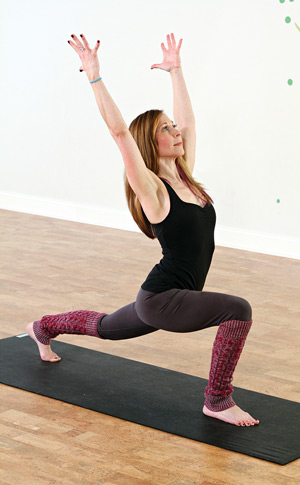
Figure 6a. Warrior I.
A survey of students in Finland who practice Ashtanga yoga found the lower extremity was the most common site for musculoskeletal injuries.7 Of the 110 students who responded to the survey, 62% reported lower extremity injuries lasting longer than one month; the hamstrings and knees were the sites most often affected, accounting for 40% and 36% of the injuries, respectively. The majority of all injuries were sprains and strains, with a small number of dislocations (n = 2) and abrasions (n = 1), but no fractures.
When the researchers excluded pre-existing injuries and nonspecific low back pain, the injury rate was 1.45 injuries per 1000 hours of yoga practice. This rate, the authors noted, is much lower than the rates associated with various other athletic activities, which ranged from 6.6 to 18.3 per 1000 hours of activity.
The Australian survey also found a relatively low incidence of events. Only 4.6% of respondents cited injuries sustained during unsupervised practice or attributed to pre-existing conditions and severe enough to require medical treatment or cause prolonged pain, discomfort, or lost work time. Injuries during supervised classes, including injury recurrences, were reported by 3.4% of respondents, and new injuries occurring under supervision were reported by 2.4%.3
Awan and González both noted that seated and standing forward bends (uttasana, Figure 4) can be particularly risky for individuals with a predisposition to hamstring injuries, including those who have had previous hamstring injuries.
“These injuries are often caused by overuse and overstretching, and it can be really hard to keep students safe in these poses even if you’re being vigilant,” González said.
Other potentially risky poses include lotus pose and one-legged king pigeon pose (eka pada rajakapotasana, Figure 5). Both involve hyperflexion and rotation at the knee, and can lead to meniscus injuries, particularly in people with tight hips, Wendel said.
“Using preparatory poses or props to limit the flexion and rotation of the knee may make these poses safer,” Awan said.
The IAYT survey warrior I (virabhadasana, Figure 6a) and warrior II (Figure 6b), hero’s pose (virasana, Figure 7), one-legged king pigeon pose, and lotus pose were the asanas most frequently associated with knee injuries. All involve knee flexion, and warrior poses combine this with weight bearing.5
A 2013 PloS One review of case studies and series also found lotus pose was a high-risk pose; lower extremity injuries associated with this asana included epiphyseal fracture of the distal tibia and lateral femoral cutaneous neuropathy.8
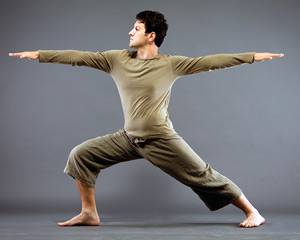
Figure 6b.Warrior II.
Evaluation, rehabilitation
As noted, yoga-related injuries can come on gradually or occur acutely.
“It’s extremely important to understand the style of a patient’s yoga practice and, for acute events, what they were doing when they sustained the injury—much like an injury sustained during any other sport,” said Sameer Dixit, MD, an assistant professor of orthopaedics, medicine, and physical medicine and rehabilitation at Johns Hopkins School of Medicine in Baltimore, MD. “It’s also important for practitioners to understand that you can injure yourself during yoga. My first exposure to a yoga injury was a young woman who tore her ACL [anterior cruciate ligament] while bending forward in hyperflexed position at the knee. I was surprised—I was working with a football team at the time and realized this type of injury can happen with yoga, as well.”
Dixit commonly sees patients in his practice who have injured themselves during yoga.
“I ask what they were doing, and find it helpful to Google the pose or poses in question with the patient so I know that’s in fact what they were doing. By looking at the position, I get some idea of where the stresses were occurring,” he said.
Cristina González advises practitioners who have patients with yoga injuries—or who are considering recommending yoga to their patients—to get some familiarity with the practice.
“I suggest some private or semiprivate classes with highly trained instructors,” she said. “This way, they might better understand what modifications can be made to the general movement cues patients will encounter in large drop-in classes.”
Pose modifications and avoiding repetitive movements are typical strategies used in the rehabilitation of yoga injuries.
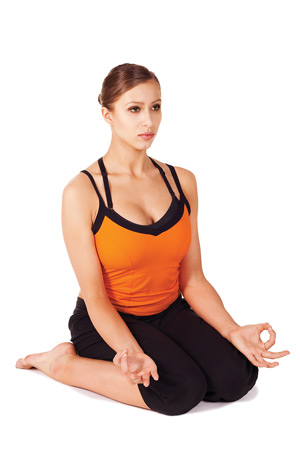
Figure 7. Hero’s pose.
“For proximal hamstring tendinopathy, avoiding repetitive forward bending is one of the first lines of treatment,” Awan said. “Rehabilitation may focus on manual therapies, but also identifying and treating any weakness, tightness, and muscle imbalance. In many cases, weak gluteal and hamstring musculature may be contributing to the clinical picture. Restrictions in the posterior kinetic chain, such as tightness in the lower hamstrings or calf, may also need to be addressed.”
In patients with patellofemoral pain syndrome, he suggests strengthening around the knee, where there is potential for patellar maltracking.
“In many cases, there is also hip weakness or tightness that is contributing to the clinical picture,” he said. “Ensuring proper alignment of the patella during standing poses with knee flexion is important. Manual therapy and stretching and strengthening around the hip and knee joint are typically required in these cases.”
With respect to rehabilitating from meniscal tearing, he said, it’s crucial to initially avoid poses that involve hyperflexion, knee rotation, or both.
“During standing poses where the knee is flexed, it’s also important to look at the tracking of the knee, as there may be significant rotation present. Strengthening around the knee joint may be helpful, but in many cases it’s also important to look at the hip joint,” Awan said. “Tightness or weakness in the hip can lead to malalignment at the knee joint in many poses and needs to be addressed.”
“Many physical therapists incorporate yoga into treatment plans to assist patients in building strength and mobility,” said Ann Wendel. “A physical therapist with expertise in yoga can assist clients and practitioners in finding appropriate modifications that reduce the risk of injury.”
She recalled one of her teachers, who stopped a class because she saw people were trying to force themselves into one-legged king pigeon pose.
“She said, ‘What I want you to understand is that pigeon is maybe sitting on the ground with your front leg bent with your hips and buttocks up on a block and your hip just slightly externally rotated; and this is also pigeon—taking the block away and just bending your knee and externally rotating the hip a little more; and this is pigeon, with your front knee fully bent and hip more externally rotated but your back leg straight; and then this is also pigeon, with the front knee bent fully and fully externally rotated, no block, and your back leg bent so your knee is bent, and your foot is coming up to your head.’”
Blocks, bolsters, blankets (folded for padding and height), and straps can all be used to modify yoga poses. Yoga Journal maintains an online yoga encyclopedia covering pose variations, modifications, contraindications, and other information at yogajournal.com/yogapedia.
“Yoga is really not about the ego and what we can make the body look like. If we keep the ego out of it as students and also as teachers, then we can bring those props and other modifications in as needed to keep everybody safe,” Wendel said. “I tell my students, the best yoga class you can attend is the one where you don’t know anything about anyone else there; you’re just looking at the mat and are very focused on your own practice—that’s how you’re going to keep yourself safe.”
1. Awan R. Yoga Injury Epidemiology.zalezhttps://www.youtube.com/watch?v=3cA9MO4mbjQ. Accessed March 27, 2015.
2. Zhu JK, Wu LD, Zheng RZ, Lan SH. Yoga is found hazardous to the meniscus for Chinese women. Chin J Traumatol 2012;15(3):148-151.
3. Penman S, Chohen M, Stevens P, Jackson S. Yoga in Australia: Results of a national survey. Int J Yoga 2012;5(2):92-101.
4. Samuel G. The Origins of Yoga and Tantra. Cambridge University Press; 2008.
5. Fishman LM, Saltonstall E, Genis S. Understanding and preventing yoga injuries. Int J Yoga Ther 2009;19:47-53.
6. Le Corroller T, Vertinsky AT, Hargunani K, et al. Musculoskeletal injuries related to yoga: Imaging observations. AJR Am J Roentgenol. 2012;199(2):413-418.
7. Mikkonen J, Pedersen P, McCarthy PW. A survey of musculoskeletal injury among Ashtanga Vinyasa yoga practitioners. Int J Yoga The. 2008;18:59-65.
8. Cramer H, Krucoff C, Dobos G. Adverse events associated with yoga: a systematic review of published case reports and case series. PLoS One. 2013;8(10):e75515.









I’ve been practising Iyengar yoga for about 5 years.. before that other yoga classes. I fell and had a multiple fracture in my right ankle because the yoga instrutcor used a strap on my right bent leg during tree pose with wall behind me. We were a small class of 4, however,
I lost my balance and fell to the right side – the result was complete inability to stop my fall and subsequent major injury. Would appreciate comments. Thank you.
Low lunge is one of the easy beginner’s postures that stretches your hips and groins. This is also the most effective yoga poses for wider hips. However, people who are suffered from a knee injury should avoid this posture.